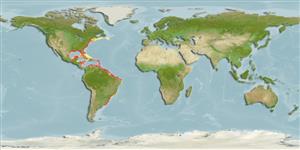Malacostraca |
Decapoda |
Portunidae
Environment: milieu / climate zone / depth range / distribution range
Ecology
Benthopelagic; freshwater; brackish; depth range 0 - 90 m (Ref. 109245), usually 0 - 35 m (Ref. 367). Tropical; 6°C - 30°C (Ref. 105839), preferred 25°C (Ref. 107945); 47°N - 36°S, 125°W - 34°W
Western Atlantic: From Nova Scotia to Rio de la Plata, Argentina. Introduced in the eastern Atlantic, North Sea, Mediterranean Sea, Adriatic Sea, Black Sea and Indo-Pacific. Tropical to temperate.
Length at first maturity / Size / Weight / Age
Maturity: Lm 12.8, range 13 - 13 cm Max length : 22.7 cm WD male/unsexed; (Ref. 367); max. reported age: 3.00 years (Ref. 105839)
Carapace more than twice as broad as long; 9 blunt to acuminate teeth (outer orbital tooth and strong lateral spine included) on arched anterolateral margin; front (excluding inner orbital angles) bearing 2 obtuse to acuminate, broadly triangular teeth with often sinuous inner margins longer than outer margins. Much of convex dorsal surface smooth, but scattered and transverse lines of fine granules; sculpture of regions near center varying from low and smooth to rather sharply raised relief with crowded granules; pincers strong, dissimilar, and ridged longitudinally; fifth legs flattened in form of paddles. Males with T-shaped abdomen level of thoracic sternite 4; slender first pleopods with membranous tip reaching beyond suture between thoracic sternites 4 and 5; sinuously curved overlapping proximally and armed distally with a row of large and small retrogressive spinules. Color: greyish, bluish, or brownish green. Males with propodi of chelae blue on inner and white on outer surfaces, fingers blue on inner and white on outer surfaces and tipped with red. Mature females with orange fingers on chelae tipped with purple. Underparts off-white with tints of yellow and pink. Color variations is associated with sexual dimorphism and molt cycle.
An epibenthic omnivore, that is active and abundant in shallow habitats (Ref. 087949). Longevity was estimated from a population of blue crabs in Chesapeake Bay (Ref. 105839). Benthopelagic (Ref. 97531). Hatching occurs in mouths of estuaries and shallow marine waters, development of larvae progresses in the ocean, followed by migration of megalopae and young crabs back into estuarine waters to mature into adults (Ref. 367). Found on soft bottoms (Ref. 106866). Burrows in muddy-sand bottoms (Ref. 108781). Juveniles occur on seagrasses. Highly cannibalistic; adult conspecifics are observed attacking tethered juveniles (Ref. 106866). Appears to be an opportunistic feeder (Ref. 108779).
Members of the order Decapoda are mostly gonochoric. Mating behavior: Precopulatory courtship ritual is common (through olfactory and tactile cues); usually indirect sperm transfer.
Tavares, M. 2003. (Ref. 367)
IUCN Red List Status (Ref. 130435)
CITES status (Ref. 108899)
Not Evaluated
Not Evaluated
Threat to humans
Human uses
Fisheries: commercial
FAO - Aquaculture: production; Fisheries: landings, species profile | FishSource | Sea Around Us
Tools
Internet sources
Estimates based on models
Preferred temperature
(Ref.
115969): 12.3 - 28, mean 24.4 (based on 788 cells).
Resilience
High, minimum population doubling time less than 15 months (K=0.5-1.59; tmax=3).
Prior r = 0.89, 95% CL = 0.59 - 1.34, Based on 2 full stock assessments.
Vulnerability
Low vulnerability (13 of 100).
Nutrients: Calcium = 109 [35, 184] mg/100g; Iron = 1.59 [1.21, 1.97] mg/100g; Protein = 20.2 [19.2, 21.3] %; Omega3 = 0.285 [0.185, 0.386] g/100g; Selenium = 48.3 [-31.7, 128.3] μg/100g; VitaminA = 0 μg/100g; Zinc = 1.79 [1.17, 2.40] mg/100g (wet weight).
